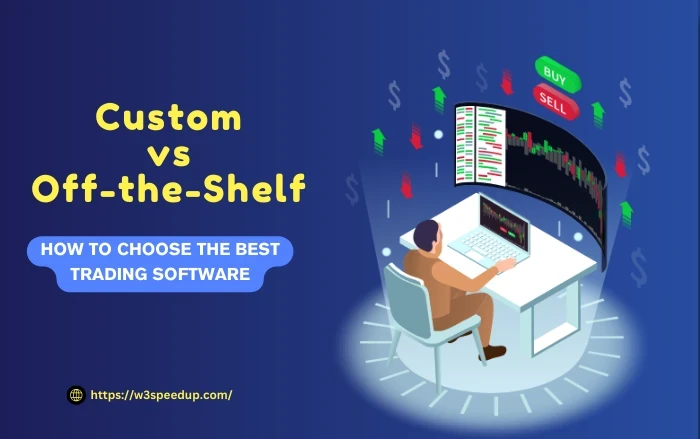Trading software refers to computer programs that assist traders in analyzing financial markets and executing trades. And although this article is going to solely focus on trading software, it’s worth mentioning that utilizing a top-tier trading firm (e.g., Goat Funded Trader, The5ers, Trading Pips, etc.) is just as important as the software you use to analyze markets. This software provides tools and features that can help traders with key aspects of trading, such as identifying trading opportunities, managing risk, automating trades, backtesting strategies, and more. Trading software can be purchased off-the-shelf from vendors or custom-developed to meet a trader’s specific requirements.
How Trading Software Works
Trading software utilizes technical analysis techniques to process and make sense of financial market data. It can analyze price charts, indicators, patterns, news events and more to generate trading signals and opportunities. If you want to learn more about the development of such software, visit URL and find out which solution is right for you. Some common features of trading software include:
- Charting tools – visualize market data through charts and graphs. Allows for the analysis of price trends, patterns, indicators, etc.
- Scanning/Screening – scan markets for trading opportunities meeting specified criteria. Helps quickly identify stocks to trade.
- Backtesting – test the effectiveness of trading strategies by applying them to historical data. Helps refine strategies.
- Automated trading – execute trades automatically based on configured rules and strategies. Hands-free trading.
- Risk management – manage overall portfolio risks through position sizing, diversification and stop losses.
- Market research – news, earnings data, filings, economic events, and sentiment analysis integrated for fundamental analysis.
- Custom indicators – create proprietary indicators and strategies for unique analysis.
Using these features prudently can augment a trader’s skills in technical, quantitative and fundamental analysis. The software does not make trading decisions on its own, and traders have to configure and interpret the generated outputs.
Choosing Trading Software
There are many trading software solutions to choose from, including:
- Off-the-shelf platforms – Readymade software like MetaTrader, TradeStation, NinjaTrader etc. Generally cheaper but less customizable.
- Proprietary broker platforms – Software offered by specific brokerages tailored to their account types and asset classes.
- Fintech apps and tools – Specialized software focused on specific capabilities like analysis, automation, risk management etc.
- Custom development – Get software built from the ground up for your unique requirements and workflows. Costlier but complete customization.
When selecting trading software, traders should evaluate features, asset class and market coverage, ease of use, automation capabilities, development frameworks, costs, reliability and security. Other aspects to consider are ecosystem and community support, backtesting facilities, strategy optimization and trade execution connectivity.
It’s important to match software capabilities to your trading style; assets traded, data and integration needs, technical skills and costs. Check reviews and community feedback before choosing a platform.
Key Advantages of Using Trading Software
The size of the world market for online trading platforms was estimated at $9.32 billion in 2022 and is expected to increase to $15.34 billion by 2030 from $9.94 billion in 2023. Incorporating trading software into one’s process offers several valuable benefits that can enhance overall trading performance. The main advantages are:
 1. Superior Market Analysis
1. Superior Market Analysis
Trading software enables comprehensive analysis of vast amounts of historical and real-time market data at speeds impossible for manual analysis. Screeners can rapidly filter through thousands of instruments, and complex combinations of indicators can identify patterns that may be difficult to spot manually. This augmented analysis allows uncovering trading opportunities that could potentially be missed otherwise.
 2. Effective Strategy Development
2. Effective Strategy Development
The backtesting capabilities provided by trading software allow traders to test and refine strategies on historical data extensively. Multiple scenarios can be evaluated to fine-tune rules, remove biases and improve performance before risking real capital. This helps formulate robust trading systems.
 3. Efficient Execution and Risk Management
3. Efficient Execution and Risk Management
Executing trades manually requires constant monitoring of markets, which can be taxing. Trading software enables setting up automated strategies that can capitalize on opportunities rapidly without manual intervention. Risk can also be managed methodically by configuring stop losses, setting position sizing rules and enforcing portfolio diversification.
 4. Enhanced Consistency and Discipline
4. Enhanced Consistency and Discipline
Software adheres precisely to configured trading rules without being influenced by emotions, bias or cognitive fatigue. This promotes consistency and discipline in trading. Detailed record keeping also allows analyzing past decisions objectively.
Overall, trading software used prudently serves as an invaluable tool for amplifying a trader’s market edge and potential. But human oversight remains essential for sustainable success.
Potential Limitations of Trading Software
Despite their advantages, trading software solutions do have some limitations traders should be aware of:
- Software can fail – Outages and glitches can prevent the execution of trades, leading to missed opportunities and losses. Redundancy is required.
- Over-optimization – Too much curve fitting on historical data can lead to unreliable models. Out-of-sample testing is essential.
- False sense of security – Over-reliance on software can breed complacency. Human oversight is still vital.
- Steep learning curve – Sophisticated software has a learning curve. Sufficient time must be invested to use it effectively.
- Potential costs – Top-quality software and market data can require high upfront and ongoing costs. The expenditure may not suit all trader budgets.
- Complexity – Juggling different systems and managing integrations between various applications can be challenging. Keeping things simple works best for many traders.
- Maintenance needs – Software requires ongoing maintenance, troubleshooting of problems and platform upgrades. This competes for trader’s time.
Overall, trading software requires discretion and should not be used as a crutch. When utilized judiciously, it can certainly amplify a trader’s potential. But human intuition, wisdom and oversight are still key. As they say – “Don’t outsource your eyes, ears or brain!”.
Custom Trading Software vs Off-the-Shelf Platforms

Traders have the option to either purchase an off-the-shelf trading platform or have custom trading software built specifically for their requirements. Below is a comparison between the two approaches:
 Off-the-Shelf Platforms
Off-the-Shelf Platforms
- Readymade software like MetaTrader, TradeStation etc.
- Generally cheaper to purchase and quick to implement.
- Packed with commonly used features and tools.
- Limited customization and Less flexibility in adopting new techniques.
- Constrained with vendor functionality roadmap and release cycles.
 Custom Trading Software
Custom Trading Software
- Built from the ground up for your specific needs.
- Provides complete flexibility to incorporate any tools, strategies, data sources etc.
- Allows creating a competitive edge with proprietary algorithms and automation.
- Integration with in-house infrastructure and systems is streamlined.
- Higher upfront development effort and costs.
- Ongoing enhancement and maintenance overhead.
Custom trading software makes sense for hedge funds, prop trading firms, sell-side institutions and high-frequency traders where proprietary strategies and performance differentiation are crucial. They have the capital to invest in development costs.
For most retail traders and small firms, off-the-shelf software provides the best value. The packages offer adequate functionality for discretionary and automated trading. And development skills are not a prerequisite to use them. With their larger user bases, vendors keep enhancing these platforms regularly. So, capabilities continue to grow.
Selecting the right software boils down to honestly assessing one’s specific requirements, capabilities, resources and constraints. For many, starting with an off-the-shelf platform and eventually graduating to custom software as needs evolve is a pragmatic approach.
Key Takeaways
- Trading software provides valuable tools for market analysis, strategy backtesting, automated trading and risk management.
- Choose software wisely based on trading style, assets traded, features, costs and ease of use.
- Utilize trading software prudently as a tool for enhancing trading outcomes, not as a crutch.
- Custom software makes sense for large firms with resources to invest in technology and require proprietary systems. Retail traders are often better off with off-the-shelf platforms due to lower costs.
- Be realistic about one’s specific needs and resources when choosing between custom and off-the-shelf trading software.
Trading software aims to enhance a trader’s market edge and lift performance. But human discretion, oversight and learning remain essential to achieve sustainable success. Software is ultimately a tool; wisdom is more important.
 Christmas Mega Sale – Enjoy Up to 50% OFF on Every Plan!
Christmas Mega Sale – Enjoy Up to 50% OFF on Every Plan! 


